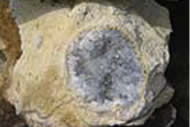
Road & Geosite Conditions
Partially Accessible
- Number
- Area
- 1. Ichiburi Geosite
- 2. Oyashirazu Geosite
- 3. Omi Coast Geosite
- 4. Omigawa Jade Gorge Geosite
- 5. Imai Geosite
- 6. Itoigawa-Shizuoka Tectonic Line and Salt Trail(North) Geosite
- 7. Maikomidaira Geosite
- 8. Hashidate Gold Mine Geosite
- 9. Kotakigawa Jade Gorge Geosite
- 10. Tsugami Shindo Geosite
- 11. Himekawa Gorge Via Oito Line Geosite
- 12. Itoigawa-Shizuoka Tectonic Line and Salt Trail(South) Geosite
- 13. Himekawa Gorge Geosite
- 14. Renge Geosite
- 15. Itoigawa Coast Geosite
- 16. Miyama Park and Museums Geosite
- 17. Tsukimizunoike Geosite
- 18. Umidani Gorge Geosite
- 19. Amakazariyama Geosite
- 20. Yakeyama Geosite
- 21. Benten-iwa Geosite
- 22. Shindosan Geosite
- 23. Gongendake Geosite
- 24. Tsutsuishi Hamatokuai Geosite
- Jade
- 1. Ichiburi Geosite
- 2. Oyashirazu Geosite
- 3. Omi Coast Geosite
- 4. Omigawa Jade Gorge Geosite
- 9. Kotakigawa Jade Gorge Geosite
- 15. Itoigawa Coast Geosite
- 16. Miyama Park and Museums Geosite
- Fossa Magna
- 5. Imai Geosite
- Itoigawa-Shizuoka Tectonic Line and Salt Trail(North) Geosite
- 11. Himekawa Gorge Via Oito Line Geosite
- 12. Itoigawa-Shizuoka Tectonic Line and Salt Trail(South) Geosite
- 13. Himekawa Gorge Geosite
- 17. Tsukimizunoike Geosite
- 21. Benten-iwa Geosite
- 22. Shindosan Geosite
- 24. Tsutsuishi Hamatokuai Geosite
- Mountainous areas
- 7. Maikomidaira Geosite
- 8. Hashidate Gold Mine Geosite
- 10. Tsugami Shindo
- 14. Renge Geosite
- 18. Umidani Gorge Geosite
- 19. Amakazariyama Geosite
- 20. Yakeyama Geosite
- 23. Gongendake Geosite

This region is located on the west side of the Itoigawa-Shizuoka Tectonic Line, along the west bank of the Himekawa River mouth. Here there are green tuff formations created by submarine volcanic activity during the formation of Fossa Magna.
From this unusual rocky outcrop, we now know that green tuff formations were formed here by tectonic action along the Itoigawa-Shizuoka Line some 17 million years ago. From this outcrop, the view of Fossa Magna and the Itoigawa-Shizuoka Tectonic Line is superb, with mountains spreading as far as the eye can see.
In this green tuff stratum, remains of former mining tunnels and other facilities remain. In addition, this area is rich in acid clay, a material used in the production of desiccants and in the purification of oil. In Japan, this material is only found here and in Tainai City, in northern Niigata prefecture.
Also in Imai one can find Fudotaki Fall, a 3-step, 70 meter waterfall comprised of Paleozoic rock, and a campground and a pond home to many dragonflies.
 Fudotaki Falls
Fudotaki Falls
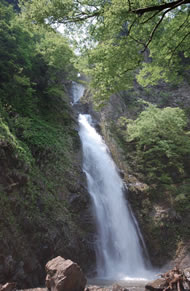
Fudotaki Falls
This 3-tiered waterfall drops from a height of 70 meters. Nestled deep in mountains and forest, it is a popular escape from the heat of summer and the adjoining park features barbecue pits, campgrounds and more.
Local legend says that a dragon god lives in this waterfall. If the water of this area is ever dirtied, the god will punish the people with storms and floods. A small shrine at the waterfall is dedicated to this god’s worship.
While also enjoyable in summer and autumn, the waterfall is at its most impressive in spring when the snow is melting.
 Mushikawa Checkpoint Site
Mushikawa Checkpoint Site

Mushikawa Village
The small community of Mushikawa, named for the nearby river, was an important stop on the western route of the Salt Trail. A “sekisho” checkpoint was built in this village at the order of local lord Uesugi Kenshin in the 16th century. Checkpoints like this one served to control the flow of goods and people along the major roads of ancient Japan.
Today, the former village of Mushikawa is mostly uninhabited, although some maintain summer residences here in order to work their family fields.
 Salt Trail - West Route
Salt Trail - West Route

Kenshin-Shingen Jizo
The Salt Trail was once an important road which connected Itoigawa to the city of Matsumoto in what is now Nagano Prefecture. Also called the Matsumoto Highway or Itoigawa Highway, it was an invaluable trade route which supplied Nagano prefecture with salt which in those days was essential for the preservation of food.
Because crossing the Himekawa River was difficult in those days, the Salt Trail had two routes. The more well-known eastern route passed through the Ono and Nechi regions while the western route passed through here. The two routes converged in what is now Otari Village.
Nowadays, the Salt Trails western route is enjoyed by hikers for its spectacular views and lush natural scenery.
 Suzawa Swamp Lanterns
Suzawa Swamp Lanterns
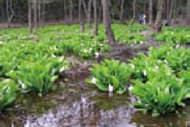
Swamp Lanterns
Swamp lanterns are rare, beautiful plants that grow in cold marshland areas. Most swamp lanterns in Japan are located at high altitudes, but the swamp lanterns naturally growing here in the Suzawa region are at an elevation of only 5 m above sea level and only about 1 km from the coast!
Swamp lanterns are more commonly called “skunk cabbage” because many varieties give off a pungent, somewhat unpleasant odor, but these swamp lanterns are odorless. This unusual colony of over 5000 plants blooms in mid March through mid April and is an exceptionally beautiful sight.
Former Site of Imai Mine
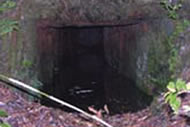
Former Entrance to Imai Mine
In Japan’s early modern era, the Imai region was heavily mined for its mineral resources. In the 1920s a number of acid clay quarries were built and in the 1930s the quarrying of gravel and silica began. These quarries continue even to this day.
The Imai Mine is a metal ore mine that operated long ago but has long since been abandoned. The tunnel entrance can still be seen today.
Yatsuroishi Stone
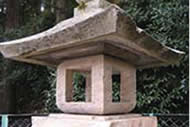
Stone Lantern
Yatsuroishi is a kind of rhyolitic tuff (volcanic rock formed from ash) that has long been a popular building material in Japan. From the Edo period it was used in the Itoigawa area to make stone lanterns, steps and pedestals which can still be seen today in shrines around Itoigawa City.
The stone was long valued for being very easy to carve yet resistant to erosion and was quarried in large amounts in the Imai Region.


